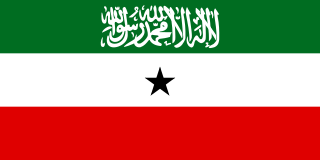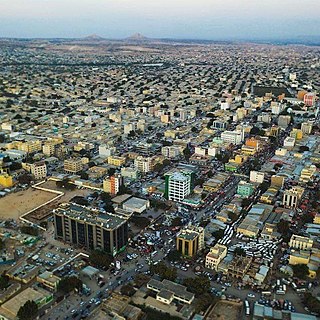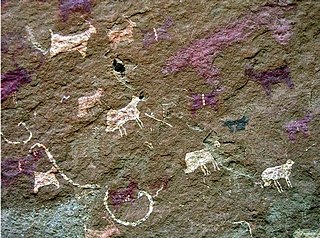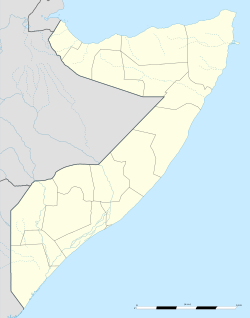
Somaliland, officially the Republic of Somaliland, is an unrecognised country in the Horn of Africa, recognised internationally as de jure part of Somalia. It is located in the southern coast of the Gulf of Aden and bordered by Djibouti to the northwest, Ethiopia to the south and west, and Somalia to the east. Its claimed territory has an area of 176,120 square kilometres (68,000 sq mi), with approximately 6.2 million residents as of 2024. The capital and largest city is Hargeisa. The Government of Somaliland regards itself as the successor state to British Somaliland, which, as the briefly independent State of Somaliland, united from 1960 to 1991 with the Trust Territory of Somaliland to form the Somali Republic.

In archaeology, cave paintings are a type of parietal art, found on the wall or ceilings of caves. The term usually implies prehistoric origin. These paintings were often created by Homo sapiens, but also Denisovans and Neanderthals; other species in the same Homo genus. Discussion around prehistoric art is important in understanding the history of the Homo sapiens species and how Homo sapiens have come to have unique abstract thoughts. Some point to these prehistoric paintings as possible examples of creativity, spirituality, and sentimental thinking in prehistoric humans.

Sanag is an administrative region (gobol) in north eastern Somaliland. Sanaag has a long coastline facing the Gulf of Aden to the north, and is bordered by the region of Sahil to the west, Sool to the south and Somalia to the east. The region is disputed by the self-declared Republic of Somaliland and Puntland, a Federal Member State of Somalia. Its capital city is Erigavo. Sanaag is the largest region of Somaliland, accounting for 35% of Somaliland's total land area.

Hargeisa is the capital and largest city of the Republic of Somaliland, a de facto sovereign state in the Horn of Africa, still considered internationally to be part of Somalia. It is also the regional capital of the Maroodi Jeex region of Somaliland.

Las Qoray is a historic coastal town in the Sanaag region of Somaliland.

The history of Somaliland, a country in the eastern Horn of Africa bordered by the Gulf of Aden, and the East African land mass, begins with human habitation tens of thousands of years ago. It includes the civilizations of Punt, the Ottomans, and colonial influences from Europe and the Middle East.

Laas Geel, also spelled Laas Gaal, are cave formations on the rural outskirts of Hargeisa, Somaliland, situated in the Maroodi Jeex region of the country. They contain some of the earliest known cave paintings of domesticated African aurochs in the Horn of Africa. Laas Geel's rock art is estimated to date to circa 3,500-2,500 BCE.

The following is an index of Somalia-related articles.

El Ayo, also known as El Ayum, is a coastal town in the eastern Sanaag region of Somaliland.
Tourism in Somalia is regulated by the Federal Government of Somalia's Ministry of Tourism. The industry was traditionally noted for its numerous historical sites, beaches, waterfalls, mountain ranges and national parks. After the start of the civil war in the early 1990s, the Tourism Ministry shut down operations. It was re-established in the 2000s, and once again oversees the national tourist industry. The Mogadishu-based Somali Tourism Association (SOMTA) provides on-the-ground consulting services.
Tourism in Somaliland is regulated by the Somaliland's Ministry of Tourism.

Somali nationalism is a nationalist ideology advocating for the unification of all Somali people who share a common ethnicity, language, and culture, under a single banner. Its earliest manifestations has its roots in the Middle Ages and the Adal Sultanate whilst in the contemporary era its often traced back to the Somali Youth League, a political organisation founded in 1943. The Somali Youth League became one of the most influential political parties in Somalia prior to post-independence. The Somali guerilla militia Al-Shabab is also noteworthy for incorporating Somali nationalism into its Islamist ideology.

Dhambalin is an archaeological site in the central Sahil province of Somaliland. The sandstone rock shelter contains rock art depicting various animals such as horned cattle and goats, as well as giraffes, an animal no longer found in the country. The site also features the earliest known pictures of sheep in Somaliland. Discovered in autumn 2007, residents of Beenyo Dhaadheer reported the rock art to the Somali archaeologist Sada Mire, Director of the Department of Archaeology within the Ministry of Tourism and Culture of Somaliland.

The Port of Las Khorey, also known as the Las Khorey Port, is the official functioning seaport of Las Khorey, situated in Somalia
Gelweita, also known as Las Galwayta or Galwayta is an archaeological site and a key rock art site in the eastern Sanaag region of Somaliland.
Golharfo is an archaeological site in the Sool region of Somaliland.

Gaanlibah or Ga'an Libah English : The lion hand) is a mountain range, archaeological site, and national park located in the Maroodi Jeex region of Somaliland. Nearby are the Golis Mountains. Its upper slopes are the source of the seasonal Togdheer river that flows through the city of Burao into the Nugaal Valley. the area is wholly dominated by the Garhajis clan.
Kal-Sheikh is an archaeological site in the Sahil region of Somaliland.
The following is an index of Somaliland-related articles.

Somaliland has many caves, some of which remain undiscovered. Such is the quality of the paintings that at least 10 sites, scattered across semi-desert terrain, are likely to be given World Heritage status.














